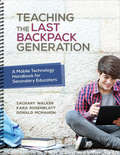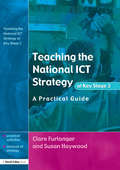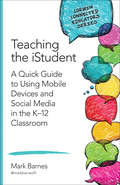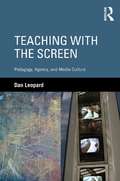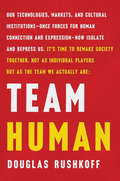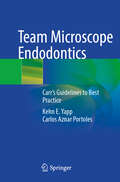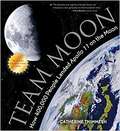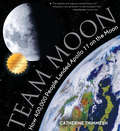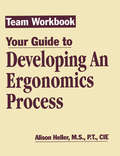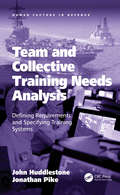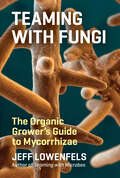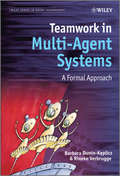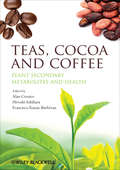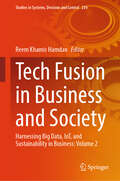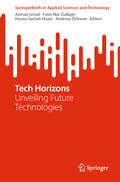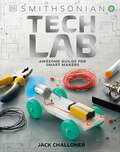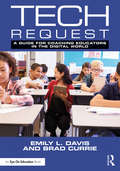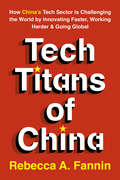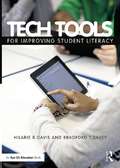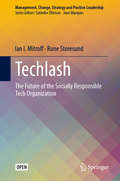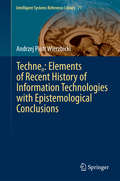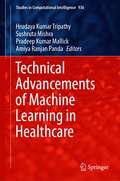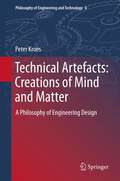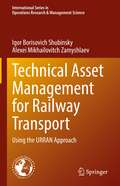- Table View
- List View
Teaching the Last Backpack Generation: A Mobile Technology Handbook for Secondary Educators
by Zachary Walker Kara Rosenblatt Don McMahonDon’t just know how to use mobile technology. Know how to use it to transform learning. This refreshingly easy-to-use workbook shows how to make mobile devices a natural part of lessons, no matter the content. Discover practical device management skills, fun strategies students will love, and helpful resources to extend professional learning.
Teaching the National ICT Strategy at Key Stage 3: A Practical Guide
by Clare Furlonger Susan HaywoodFirst Published in 2005. Routledge is an imprint of Taylor & Francis, an informa company.
Teaching the iStudent: A Quick Guide to Using Mobile Devices and Social Media in the K-12 Classroom (Corwin Connected Educators Series)
by Mark D. BarnesMeet digital natives on their own turf! Our students are already accustomed to constantly-evolving mobile technology and they crave more than what plain paper and pencil can provide. Veteran teacher, renowned author, and tech expert Mark Barnes shows educators how to use mobile devices and social media to create a win-win for teaching and learning. This inspiring resource describes how to: Mentor students in responsible use of technology Build students’ aptitudes for critical thought and content curation Encourage collaboration beyond the classroom walls Easily learn and introduce new technology Including real-life teaching examples and exciting K-12 lesson ideas, along with a teacher-friendly technology glossary.
Teaching the iStudent: A Quick Guide to Using Mobile Devices and Social Media in the K-12 Classroom (Corwin Connected Educators Series)
by Mark D. BarnesMeet digital natives on their own turf! Our students are already accustomed to constantly-evolving mobile technology and they crave more than what plain paper and pencil can provide. Veteran teacher, renowned author, and tech expert Mark Barnes shows educators how to use mobile devices and social media to create a win-win for teaching and learning. This inspiring resource describes how to: Mentor students in responsible use of technology Build students’ aptitudes for critical thought and content curation Encourage collaboration beyond the classroom walls Easily learn and introduce new technology Including real-life teaching examples and exciting K-12 lesson ideas, along with a teacher-friendly technology glossary.
Teaching with the Screen: Pedagogy, Agency, and Media Culture
by Dan LeopardTeaching with the Screen explores the forms that pedagogy takes as teachers and students engage with the screens of popular culture. By necessity, these forms of instruction challenge traditional notions of what constitutes education. Spotlighting the visual, spatial, and relational aspects of media-based pedagogy using a broad range of critical methodologies–textual analysis, interviews, and participant observation–and placing it at the intersection of education, anthropology, and cultural studies, this book traces a path across historically specific instances of media that function as pedagogy: Hollywood films that feature teachers as protagonists, a public television course on French language and culture, a daily television "news" program created by high school students, and a virtual reality training simulation funded by the US Army. These case studies focus on teachers as pedagogical agents (teacher plus screen) who unite the two figures that have polarized earlier debates regarding the use of media and technology in educational settings: the beloved teacher and the teaching machine.
Team Human
by Douglas Rushkoff“A provocative, exciting, and important rallying cry to reassert our human spirit of community and teamwork.”—Walter Isaacson Team Human is a manifesto—a fiery distillation of preeminent digital theorist Douglas Rushkoff’s most urgent thoughts on civilization and human nature. In one hundred lean and incisive statements, he argues that we are essentially social creatures, and that we achieve our greatest aspirations when we work together—not as individuals. Yet today society is threatened by a vast antihuman infrastructure that undermines our ability to connect. Money, once a means of exchange, is now a means of exploitation; education, conceived as way to elevate the working class, has become another assembly line; and the internet has only further divided us into increasingly atomized and radicalized groups. Team Human delivers a call to arms. If we are to resist and survive these destructive forces, we must recognize that being human is a team sport. In Rushkoff’s own words: “Being social may be the whole point.” Harnessing wide-ranging research on human evolution, biology, and psychology, Rushkoff shows that when we work together we realize greater happiness, productivity, and peace. If we can find the others who understand this fundamental truth and reassert our humanity—together—we can make the world a better place to be human.
Team Microscope Endodontics: Carr’s Guidelines to Best Practice
by Kehn E. Yapp Carlos Aznar PortolesThis book is a complete guide on how to use a microscope as a team for all endodontic procedures. Readers will learn how to create an environment where every clinical task is done efficiently with the highest level of teamwork. All foundational principles are covered including how to design a surgery, choose a microscope setup, position the equipment, train an assistant, perform all procedures using the microscope and - most important of all - develop expertise. Sample plans and training guides are discussed. By following the provided outline, both operators and assistants can learn all the skills for team microscope endodontics. Whilst this is mainly written for endodontic postgraduates and endodontists, other dentists who want to become experts in microscope use will find the book valuable.
Team Moon: How 400,000 People Landed Apollo 11 on the Moon
by Catherine ThimmeshFor the kids of all those thousands and thousands of people who worked on Apollo. For the sacrifices you made--the birthday parties, ballgames, and bedtime stories that your parents had to miss because the moon was calling, and demanding their time. It must have been hard sometimes. But look at what they did! Thanks for sharing them with the world when we needed them most.<P><P> Winner of the Sibert Medal
Team Moon: How 400,000 People Landed Apollo 11 on the Moon
by Catherine Thimmesh&“This behind-the-scenes look at the first Apollo moon landing has the feel of a public television documentary in its breadth and detail&” (Publishers Weekly, starred review). Here is a rare perspective on a story we only thought we knew. For Apollo 11, the first moon landing, is a story that belongs to many, not just the few and famous. It belongs to the seamstress who put together twenty-two layers of fabric for each space suit. To the engineers who created a special heat shield to protect the capsule during its fiery reentry. It belongs to the flight directors, camera designers, software experts, suit testers, telescope crew, aerospace technicians, photo developers, engineers, and navigators. Gathering direct quotes from some of these folks who worked behind the scenes, Catherine Thimmesh reveals their very human worries and concerns. Culling NASA transcripts, national archives, and stunning NASA photos from Apollo 11, she captures not only the sheer magnitude of this feat but also the dedication, ingenuity, and perseverance of the greatest team ever—the team that worked to first put man on that great gray rock in the sky. Winner of the Robert F. Sibert Informational Book Award &“An edge-of-your-seat adventure . . . Lavishly illustrated . . . This exhilarating book . . . will captivate.&” —Chicago Sun-Times &“Thimmesh gives names and voices to the army that got Neil Armstrong and company to the moon and back. The result is a spectacular and highly original addition to the literature of space exploration.&” —The Horn Book &“This beautiful and well-documented tribute will introduce a new generation to that triumphant time.&” —Kirkus Reviews (starred review)
Team Workbook-Your Guide To Developing An Ergonomics Process
by Alison Heller-OnoThis workbook is designed to be used as part of the Developing an Ergonomics Process system. It can be used as a tool, helping the reader to implement strategies effectively, as the process of reducing workplace injuries and illnesses is outlined and effected.
Team and Collective Training Needs Analysis: Defining Requirements and Specifying Training Systems (Human Factors in Defence)
by Jonathan Pike John HuddlestoneMilitary capability is delivered operationally at a team and collective level, be it a unit as small as a squad or section, or as large as a maritime task group. Modern military forces are required to deal with a potentially wide range of missions frequently involving multiple alliance partners, within a geopolitical environment which can seem to change rapidly. Individual performance, while being important, is not the primary determinant of mission success - force integration, interoperability, adaptability and teamwork are key factors. Team and collective training which fully addresses these factors is fundamental to the development and delivery of military capability. As a consequence, the requirement to determine training requirements and specify effective systems for the delivery of team and collective training is critical to operational success. Training Needs Analysis (also known as Front End Analysis), is a well-established methodology for analysing training requirements and specifying training solutions used extensively by the UK and its NATO partners. However, the analytical techniques employed are optimised for individual training, with little guidance being offered on its application in the team and collective context. Team and Collective Training Needs Analysis (TCTNA) has been developed to close this methodological gap. It addresses the issues of the relationship of individual and team tasks, teamwork, command and control, task and training environments, scenario definition, instructional strategy, team training approaches, instructional functions, and wide-ranging organisational and procurement considerations. Part One of the book develops an integrated set of models which underpin the analytical approach presented in Part Two. Worked examples and case studies illustrate the application of the approach. Between 2005 and 2015 the authors worked on numerous training-related research projects at Cranfield University and Coventry University for the Human Factors Integration Defence Technology Centre and the Defence Human Capability Science and Technology Centre on behalf of the Defence Science and Technology Laboratory, UK Ministry of Defence.
Teaming with Fungi: The Organic Grower's Guide to Mycorrhizae (Science For Gardeners Ser.)
by Jeff LowenfelsFrom the bestselling author of Teaming with Microbes and Teaming with Nutrients Teaming with Fungi is an important guide to mycorrhizae and the role they play in agriculture, horticulture, and hydroponics. Almost every plant in a garden forms a relationship with fungi, and many plants would not exist without their fungal partners. By better understanding this relationship, gardeners can take advantage of the benefits of fungi, which include an increased uptake in nutrients, resistance to drought, earlier fruiting, and more. Learn how the fungi interact with plants and how to best to employ them in your home garden.
Teamwork in Multi-Agent Systems
by Barbara Dunin-Keplicz Rineke VerbruggeWhat makes teamwork tick?Cooperation matters, in daily life and in complex applications. After all, many tasks need more than a single agent to be effectively performed. Therefore, teamwork rules!Teams are social groups of agents dedicated to the fulfilment of particular persistent tasks. In modern multiagent environments, heterogeneous teams often consist of autonomous software agents, various types of robots and human beings.Teamwork in Multi-agent Systems: A Formal Approach explains teamwork rules in terms of agents' attitudes and their complex interplay. It provides the first comprehensive logical theory, TeamLog, underpinning teamwork in dynamic environments. The authors justify design choices by showing TeamLog in action.The book guides the reader through a fascinating discussion of issues essential for teamwork to be successful:What is teamwork, and how can a logical view of it help in designing teams of agents? What is the role of agents' awareness in an uncertain, dynamic environment? How does collective intention constitute a team? How are plan-based collective commitments related to team action? How can one tune collective commitment to the team's organizational structure and its communication abilities? What are the methodological underpinnings for teamwork in a dynamic environment? How does a team and its attitudes adjust to changing circumstances? How do collective intentions and collective commitments arise through dialogue? What is the computational complexity of TeamLog? How can one make TeamLog efficient in applications? This book is an invaluable resource for researchers and graduate students in computer science and artificial intelligence as well as for developers of multi-agent systems. Students and researchers in organizational science, in particular those investigating teamwork, will also find this book insightful. Since the authors made an effort to introduce TeamLog as a conceptual model of teamwork, understanding most of the book requires solely a basic logical background.
Teas, Cocoa and Coffee: Plant Secondary Metabolites and Health
by Alan CrozierIn recent years, the role of plant secondary metabolites as protective constituents in the human diet has been a growing area of research. Unlike the traditional vitamins, they are not essential for short-term wellbeing, but there is increasing evidence that modest long-term intakes can have favourable impacts on the incidence of cancers and many chronic diseases, including cardiovascular disease and type II diabetes, which are occurring in Western populations with increasing frequency. This book covers the latest science on the metabolism and potential health benefits of teas, cocoa, coffee and their extracts in the human diet. From an opening chapter tracing the origins of teas, cocoa and coffee as beverage, the book proceeds to explore the phytochemical content of coffee, cocoa and the various types of tea. The bioavailability of secondary metabolites from each of the beverages is then considered in depth, and related directly to their health benefits. Embracing the full range of tea, coffee and cocoa beverages and products, the book offers the most up-to-date and comprehensive treatment of these increasingly important dietary components. As the only book to bring together the latest information on the biochemistry and health benefits of teas, coffee and cocoa, this book is essential reading for food scientists and technologists involved in the production of tea, coffee and cocoa products. Nutritionists will value the book's health focus, while agricultural scientists working on the cultivation of these crops will prize its scope and depth of detail. It is also an important resource for all those who use functional ingredients in other products, whether they are based in industry or research.
Tech Fusion in Business and Society: Harnessing Big Data, IoT, and Sustainability in Business: Volume 2 (Studies in Systems, Decision and Control #234)
by Reem Khamis HamdanThis book embarks on a deeper exploration of the intersection of technology and business with Volume 2 of 'Tech Fusion in Business and Society: Harnessing Big Data, IoT, and Sustainability.' This book, divided into two parts—'Diving into the Nexus: Artificial Intelligence, Technology, and Societal Impact' and 'Unveiling Synergies: Artificial Intelligence, Blockchain, Security, and Business Impact'—offers a comprehensive look at how these elements shape our world. This book delves into a rich tapestry of insights from leading experts, each chapter meticulously reviewed to ensure academic excellence and practical relevance. This book discovers how AI, blockchain, security, and more converge to drive innovation and influence the future of industries and societies.
Tech Horizons: Unveiling Future Technologies (SpringerBriefs in Applied Sciences and Technology)
by Andreas Öchsner Azman Ismail Fatin Nur Zulkipli Husna Sarirah HusinThis book assembles a varied array of chapters, each delving into a distinct aspect of innovation and its practical applications. Readers will explore cutting-edge technologies and applicable techniques that aimed at enhancing academic performance. "Tech Horizon" provides an enthralling exploration of the diverse and transformative vistas within the domain of modern technology.
Tech Lab: Awesome Builds for Smart Makers (DK Activity Lab)
by Jack ChallonerThis DK children's book for ages 11-14 is brimming with exciting, educational activities and projects that focus on electronics and technology.Keep your siblings out of your room with a brilliant bedroom alarm, power a propellor motorboat, make a thermoelectric phone charger, build a set of speakers, and construct a crane by following step-by-step instructions and using affordable equipment. Tech Lab will engage budding scientists and engineers as they experiment, invent, trial, and test technology, electronics, and mechanics at home.Simple steps with clear photographs take readers through the stages of each low-cost project, with fact-filled panels to explain the science behind each one, and to fascinate them with real-world examples.With an increasing focus across school curricula on encouraging children to explore STEM subjects (science, technology, engineering, and maths), Tech Lab is the perfect companion for any inquisitive child with an interest in how the worlds of science experiments and technology work, and why."
Tech Request: A Guide for Coaching Educators in the Digital World
by Emily L. Davis Brad CurrieIn this much-needed book, experts Emily L. Davis and Brad Currie draw on their extensive experience in coaching and instructional technology and provide concrete, research-based strategies to help coaches in their day-to-day role. Whether you’re beginning a coaching initiative or looking for practical insights on coaching in a variety of settings, including in groups and one-to-one, you’ll find the resources you need to overcome challenges and grow your coaching skills. Topics include: The basics of tech coaching How to clarify on the expectations and objectives of your role Tips for recruiting teachers to work with you Guiding educators in planning and implementing meaningful technology integration How to plan and facilitate effective team coaching Strategies to gather and share data to communicate the impact of your coaching work How to stay ahead of the curve and keep learning for the future Every chapter includes practical tools, templates, and illustrative vignettes from the field to help you ensure the success of your technology coaching initiative. Join the conversation! Discuss the book and your coaching questions on Twitter with the hashtag #TechRequestEDU.
Tech Titans of China: How China's Tech Sector is challenging the world by innovating faster, working harder, and going global
by Rebecca FanninThe rise of China's tech companies and intense competition from the sector is just beginning. This will present an ongoing management and strategy challenge for companies for many years to come. Tech Titans of China is the go-to-guide for companies (and those interested in competition from China) seeking to understand China's grand tech ambitions, who the players are and what their strategy is. Fannin, an expert on China, is an internationally-recognized journalist, author and speaker. She hosts 12 live events annually for business leaders, venture capitalists, start-up founders, and others impacted by or interested in cashing in on the Chinese tech industry. In this illuminating book, she provides readers with the ammunition they need to prepare and compete. Featuring detailed profiles of the Chinese tech companies making waves, the tech sectors that matter most in China's grab for super power status, and predictions for China's tech dominance in just 10 years.
Tech Tools for Improving Student Literacy
by Hilarie B. Davis Bradford T. DaveyTechnology isn’t just fun to use in the classroom, it can also make real improvements in students’ literacy development. In this book, authors Hilarie Davis and Bradford Davey show you how and why to use tech tools to help enhance the teaching of reading, writing, speaking, listening, and viewing. These tools can be used in English/Language Arts and across the subject areas to promote literacy throughout your school. Special Features: Practical classroom examples from a variety of content areas Connections to specific Common Core State Standards "Using the Technology" boxes with step-by-step guidance on using a tool Screenshots that show how the tools work Strategies to help you use the tools effectively with students
Techlash: The Future of the Socially Responsible Tech Organization (Management, Change, Strategy and Positive Leadership)
by Ian I. Mitroff Rune StoresundTechnology has made human lives incomparably better. Civilization as we know it would utterly collapse without it. However, if not properly managed, technology can and will be systematically abused and misuse and thereby become one of the biggest threats to humankind. This open access book applies proactive crisis management to the management of technology organizations to make them more sustainable and socially responsible for the betterment of humankind. It forecasts the unintended consequences of technology and offers methods to counteract it.
Technen: Elements of Recent History of Information Technologies with Epistemological Conclusions
by Andrzej Piotr WierzbickiThe book expresses the conviction that the art of creating tools - Greek techne - changes its character together with the change of civilization epochs and co-determines such changes. This does not mean that tools typical for a civilization epoch determine it completely, but they change our way of perceiving and interpreting the world. There might have been many such epochs in the history of human civilization (much more than the three waves of agricultural, industrial and information civilization). This is expressed by the title Technen of the book, where n denotes a subsequent civilization epoch. During last fifty years we observed a decomposition of the old episteme (understood as a way of creating and interpreting knowledge characteristic for a given civilization epoch) of modernism, which was an episteme typical for industrial civilization. Today, the world is differently understood by the representatives of three different cultural spheres: of strict and natural sciences; of human and social sciences (especially by their part inclined towards postmodernism) and technical sciences that have a different episteme than even that of strict and natural sciences. Thus, we observe today not two cultures, but three different episteme. The book consists of four parts. First contains basic epistemological observations, second is devoted to selected elements of recent history of information technologies, third contains more detailed epistemological and general discussions, fourth specifies conclusions. The book is written from the cognitive perspective of technical sciences, with a full awareness - and discussion - of its differences from the cognitive perspective of strict sciences or human and social sciences. The main thesis of the book is that informational revolution will probably lead to a formation of a new episteme. The book includes discussions of many issues related to such general perspective, such as what is technology proper; what is intuition from a perspective of technology and of evolutionary naturalism; what are the reasons for and how large are the delays between a fundamental invention and its broad social utilization; what is the fundamental logical error (using paradoxes that are not real, only apparent) of the tradition of sceptical philosophy; what are rational foundations and examples of emergence of order out of chaos; whether civilization development based on two positive feedbacks between science, technology and the market might lead inevitably to a self-destruction of human civilization; etc.
Technical Advancements of Machine Learning in Healthcare (Studies in Computational Intelligence #936)
by Pradeep Kumar Mallick Amiya Ranjan Panda Hrudaya Kumar Tripathy Sushruta MishraThis book focuses on various advanced technologies which integrate with machine learning to assist one of the most leading industries, healthcare. It presents recent research works based on machine learning approaches supported by medical and information communication technologies with the use of data and image analysis. The book presents insight about techniques which broadly deals in delivery of quality, accurate and affordable healthcare solutions by predictive, proactive and preventative methods. The book also explores the possible use of machine learning in enterprises, such as enhanced medical imaging/diagnostics, understanding medical data, drug discovery and development, robotic surgery and automation, radiation treatments, creating electronic smart records and outbreak prediction.
Technical Artefacts: Creations of Mind and Matter
by Peter KroesThis book presents an attempt to understand the nature of technical artefacts and the way they come into being. Its primary focus is the kind of technical artefacts designed and produced by modern engineering. In spite of their pervasive influence on human thinking and doing, and therefore on the modern human condition, a philosophical analysis of technical artefacts and engineering design is lacking. Among the questions addressed are: How do technical artefacts fit into the furniture of the universe? In what sense are they different from objects from the natural world, or from the social world? What kind of activity is engineering design and what does it mean to say that technical artefacts are the embodiment of a design? Does it make sense to consider technical artefacts to be morally good or bad by themselves because of the way they influence human life? The book advances the thesis that technical artefacts, conceived of as physical constructions with a technical function, have a dual nature; they are hybrid objects combining physical and intentional features. It proposes a theory of technical functions and technical artefact kinds that does justice to this dual nature, analyses engineering design from the dual nature point of view, and argues that technical artefacts, because of their dual nature, have inherent moral significance.
Technical Asset Management for Railway Transport: Using the URRAN Approach (International Series in Operations Research & Management Science #322)
by Igor Borisovich Shubinsky Alexei Mikhailovitch ZamyshlaevThis book introduces readers to the key provisions of the URRAN-based technical asset management system - a methodology for managing resources and risks by analyzing and ensuring the required levels of reliability and safety in Russia’s railway transport facilities. It describes the architecture of the URRAN information system’s unified corporate platform (UCP URRAN) and its subsystems for infrastructure facilities and rolling stock complexes. It also highlights the UCP URRAN’s prospects for development, especially in the application of artificial intelligence to predict dangerous events in railway transport operation. The book is chiefly intended for specialists engaged in practical work on the technical maintenance of railway transport facilities. It can also be used as a reference guide for students and researchers at railway universities or professionals who are dealing with problems in technical asset management in other industries.
